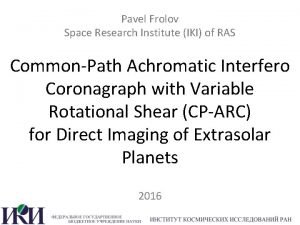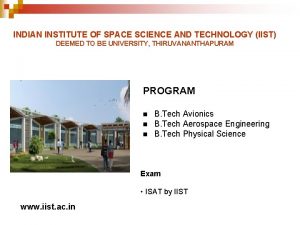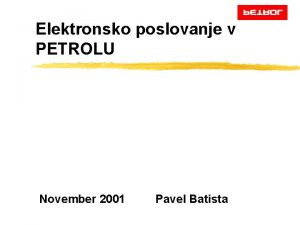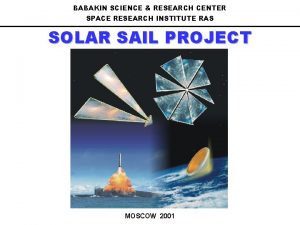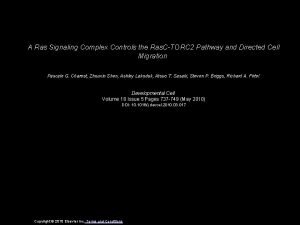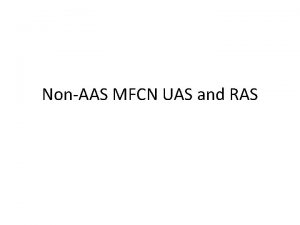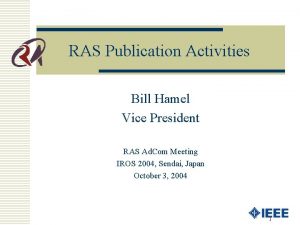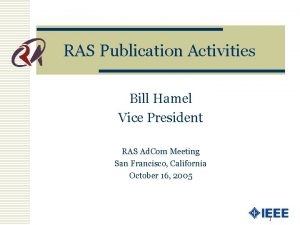Pavel Frolov Space Research Institute IKI of RAS

















- Slides: 17

Pavel Frolov Space Research Institute (IKI) of RAS Common-Path Achromatic Interfero Coronagraph with Variable Rotational Shear (CP-ARC) for Direct Imaging of Extrasolar Planets 2016

Introduction • 1988 – the first report on possible (sub) stellar companion of double star Gamma Cephei • 1992 – discovery of a planetary system around millisecond pulsar PSR B 1257+12 • 1995 – the first definitive detection of a hot Jupiter around a solar-type star 51 Pegasi • Nearly 3500 extrasolar planets have been confirmed as of May 2016 (http: //exoplanet. eu, http: //exoplanets. org), … • Plus about 3000 unconfirmed planet candidates discovered by Kepler Space Observatory (http: //exoplanetarchive. ipac. caltech. edu/docs/data. html) • Main detection methods are indirect ones: Method Transit Radial velocity Planets ~ 2600 ~ 650 Direct imaging Gravitational microlensing Timings 69 46 30

Direct imaging of exoplanets • Primary objective: – direct imaging of earth-like planet within the habitable zone around mature nearby stars AND obtaining its spectrum in a wide wavelength range • Instruments: – ground-based (limited performance due to stratospheric or space telescope – to collect light atmosphere – adaptive optics – to correct wavefront – stellar coronagraph – to suppress bright star light Very bright actually – brightness ratio is up to 10 orders of magnitude The first detection of exoplanet by direct imaging: a giant planet orbiting a young brown dwarf discovered in 2004 by VLT-UT 4 influence),

Types of coronagraphs: Stellar coronagraphs can be divided into several sets of groups. Many coronagraph approaches known to date can achieve contrast on the order of 10 -10 at IWA (inner working angle) of several λ/D and therefore able to image earth-like exoplanets around nearby stars with large telescope (about 10 meters and more) in the visible and near infrared.

The place among other coronagraphs 1997 2010 AIC Better star light suppression ARC Mechanical stability CP-AIC CP-ARC 2005 2011

Common-path achromatic Interfero Coronagraph with Variable Rotational Shear – principle and optical design (a) principle (b) optical scheme

Simulated coronagraphic image: Suppressed Sun AND giant planets of the Solar system (Jupiter, Saturn, Uranus, Neptune) at the dark output of CP-ARC. 10 parsecs away, 2. 4 m telescope, λ=0. 35… 0. 85µm, rotational shear 3. 6°, zero orbital inclination. Intensity is in logarithmic scale, dynamic range (between black and white) is six orders of magnitude

Variable rotational shear – why?

Laboratory prototype

Laboratory testbed

CP-ARC. Experiment on the suppression of simulated star Green laser represents the star, red laser represents the planet (initially unseen over bright background) Rotational shear 180° Rotational shear 20°

CP-ARC. Experiment on the suppression of white light Rotational shear 10°, only star light (simulated), only pupil plane

CP-ARC advantages and drawbacks Pluses of CP-ARC: • Fully achromatic suppression of the star light. Achromatic performance in a wide wavelength range (typically 0. 5… 2µm). • Simple in engineering terms and mechanically stable common-path design. • Meets the requirement of imaging exo. Jupiter around nearby stars. • Works with a number of aperture shapes (circular, square, hexagon …), segmented and diluted apertures with a large number of particular values of rotational shear since the aperture is invariant under a rotation. • Can be adapted to the experimental conditions over a wide range since variable angle of rotational shear defines IWA (starting from the lowest possible) and star light suppression level. • Sensitive to the polarization of the planet light. Minuses of CP-ARC: • Increased IWA. • Still sensitive to the angular size of the star and pointing errors. • Maximum transmission of the planet light is 28% (14% in every copy of the planet). However, half of the light collected by telescope is not lost; it is linearly polarized and can be used by another instrument (the same coronagraph with another angle of rotational shear, for example). • Double image at the output complicates analysis of low-contrast or small-scale structures of the star vicinity.

CP-ARC application in space experiments: Russian space telescopes planned to be equipped with stellar coronagraph to observe exoplanets around nearby stars “Planetary Monitoring” (development stage) 60 -cm space telescope (2018++) Technological objective is to perform test observations of nearby stars with stellar coronagraph. No adaptive optics “Star Patrol” (research stage) 1. 5… 2 -m space telescope (2022+++) Meant for direct imaging and study of extrasolar planets through photometry in the visible and low resolution spectroscopy and polarimetry in the visible and near infrared

Direct imaging completed space missions PICTURE 2011 (NASA) (Planet Imaging Concept Test bed Using a Rocket Experiment) 50 -cm telescope + adaptive optics + coronagraph VNC Launched with the sounding rocket Black Brant 9 Scientific data transmitter failure PICTURE 2015 (NASA) Another attempt with the same instruments Successfully completed – results are still not published

Direct imaging future space missions PICTURE-C 2017 (NASA) (Planet Imaging Concept Test bed Using a Recoverable Experiment Coronagraph) 50 -cm telescope + adaptive optics + coronagraph /// stratospheric balloon James Webb Space Telescope Oct. 2018 (NASA) Segmented 6. 5 -m primary mirror + NIRcam + MIRI + coronagraph WFIRST-AFTA mid 2020 (NASA) (Wide Field Infrared Survey Telescope - Astrophysics Focused Telescope Assets) 2. 4 -m single dish telescope + adaptive optics + coronagraph

Thank you for attention!
